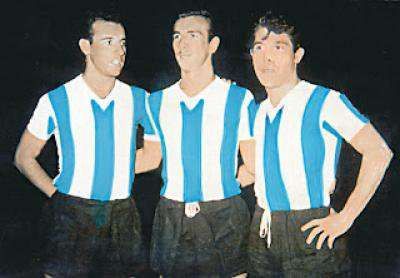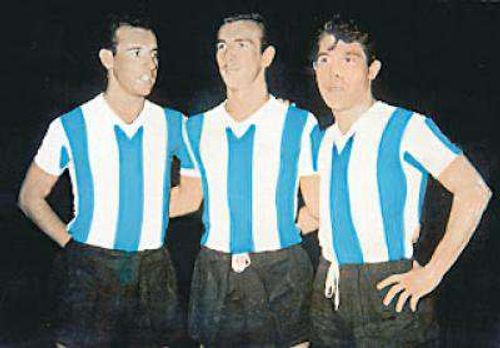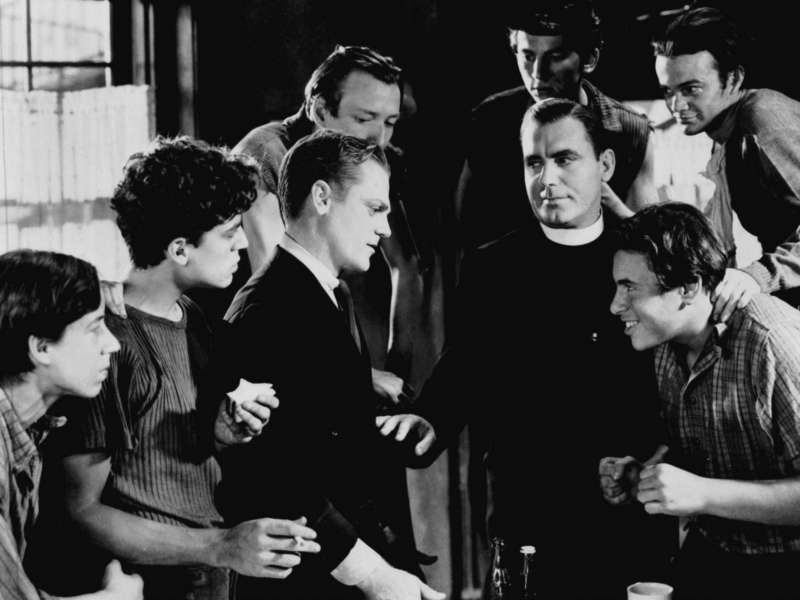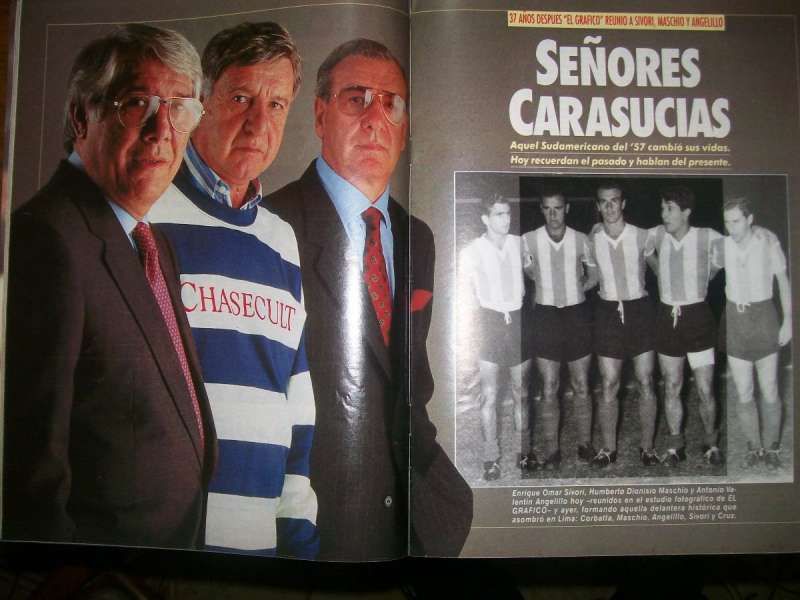
Football's greatest partnerships: Part 3 - Angels with dirty faces
Real de Nuestra Santa Maria del Buen Ayre. The city of the fair winds. The home of Boca Juniors and La Bombonera, yet located on the Western shores of Rio de la Plata, from where their arch nemesis, River Plate hail. Few cities in the world enjoy the cultural tapestry that one witnesses in Buenos Aires. And fewer follow football with the level of fervour that the capital of Argentina does.
Right from the streets of Palermo to the avenues of 9 de Julio, football is everywhere in a city that has experienced a tryst with the beautiful game rooted in a deep sense of attachment. A sense of attachment built on the blood, sweat and tears of the kids on the street of the city who went on to bear the national flag in the beloved colours of La Albiceleste for decades on end.
And nearly sixty years ago, the great city saw three of its sons rise from its streets to lead the national team to continental glory in what ranks among the greatest displays of coordinated attacking football to this day.
Humberto Maschio, Antonio Angelillo and Omar Sivori enjoyed precious little game time together compared to most other celebrated footballing partnerships. However, they were at the forefront of an Argentine juggernaut that rolled on like ploughs in the Pampas of Buenos Aires.
More significantly still, they were and still are among the most widely renowned names of a breed caught in a web of football, history and international politics – the Oriundi.
Argentina and Italy. Two of the most storied nations playing the game. Two nations at the helm of tactical innovations during every era, right from the likes of Cesar Luis Menotti and Vittorio Pozzo to the modern day names of Diego Simeone and Antonio Conte.
Also read: Football's greatest partnerships: Part 2 - That night in Barcelona
The two nations have also had an intertwined and rather controversial history of Argentines (whose ancestors were Italian rimpatriati or repatriates) moving to Italy and playing for the Azzurri. From the legendary Luis Monti in the 1930s to current Serie A players such as Gabriel Paletta and Franco Vazquez, the list is a long and hallowed one.
Lest we digress, the 1957 Copa America brought Latin America to the limelight of world football, a trend that was then perpetuated for decades on end with the arrival of Pele, Garrincha, Diego Maradona et al. Held in Peru, the tournament saw a meteor shower of goals, with 101 goals being scored in just 21 games (to put that stat into perspective, only seven more goals were scored across thirty more games in Euro 2016). 20 of those were scored by Argentina’s “Trio of death” across a mere six games.
The trio were called Carasucias or “dirty faces” back home, alluding to their typically rough and tough Latin features. Omar Sivori, who grew up in the “City of Mary” neighbourhood of San Nicholas in Buenos Aires looked like a crossover between Eli Wallach in The Good, the Bad and the Ugly and Dustin Hoffman in Midnight Cowboy.
Antonio Valentin Angelillo, one of the earliest support strikers in the game (known as inside forwards back then), sported a Salvador Dali moustache, which was fitting in the sense that the man could make the sport into art with a turn here and a flourish there.
Finally, Humberto Maschio, the deadly striker from Avellaneda, looked like Humphrey Bogart in his days of yore, with the dimpled chin and receding hairline.
And Bogart himself was partly responsible for the nomenclature with which the trio would be known the world over post their Copa America heroics – “Angels with dirty faces”. An ode to the Roaring Twenties, Angels with Dirty Faces was amongst the earliest gangster flicks of all time, and one of the biggest blockbusters of America in the pre-Golden Age era of Hollywood.
Starring that firecracker of an actor James Cagney, along with Pat O’Brien and Bogart, the iconic title of the film shot its way into footballing folklore, with even the celebrated football writer Jonathan Wilson naming his recent book on Argentine football the same.
Argentina kickstarted the Copa with a wildly entertaining 8-2 against Colombia with Maschio netting a hat-trick and Angelillo scoring a brace. It was a sign of things to come from the Albiceleste.
With all the matches being played at the historic Estadio Nacional in Lima, they went on to serve another superlative treat for their rapturous faithful in the next game, swatting aside Ecuador 3-0, with another Angelillo brace succeeding Sivori’s first goal of the tournament.
Along with Omar Oreste Corbatta, one of the greatest exponents of that dying breed – the touchline hugging winger – the Carasucias were setting the tourney alight.
Uruguay were at the receiving end of the next pasting as Maschio did the double this time around, with the ever present Angelillo also finding the back of the net once. The trio had plundered eleven goals in the space of a week.
Meanwhile, Brazil was playing its version of steamroller on other sides, beating Ecuador 7-1 (there’s something about Brazil and that scoreline) and pummeling Colombia 9-0 into submission. It was up to Argentina to up their game even further and they duly obliged.
Chile was at the end of the firing line this time around with Sivori, Angelillo (2) and Maschio (2) all scoring to ride their team to a 6-2 win. The next game, however, was the deciding one. Argentina vs Brazil – the battle of the sworn enemies, for the title no less. In a winner takes all clash predicted to be a battle of blood and thunder, Argentina came out with a performance for the ages, beating their bitter rivals 3-0 in one of La Seleccion’s most celebrated triumphs of all time. “Yes, it is a great team!” proclaimed El Grafico the following day.
Angelillo and Maschio had scored yet again, while Sivori pulled the strings behind them, famously pulling off a succession of nutmegs which would turn out to be his trademark move in the future. Victory was theirs. Glory was theirs. The boys had risen from the streets of Buenos Aires. The old continent was calling them.
Sivori, the most celebrated of the trio moved to Juventus, where we was part of another great trident, along with Giampiero Boniperti and John Charles. Angelillo moved to Inter Milan, where he won the Capacannoniere for the Serie A top scorer the following season. And the Golden Boot winner of the Copa, Maschio moved to Bologna.
The trio didn’t play together again. To further drive a dagger into Argentine hearts, they then turned up for the Italian national team.
Tormented by the exodus of his compatriots, Corbatta turned to drinking and never hit the heights of his glory days again. Angelillo’s departure enraged the higher ups in Argentina to such an extent that the military dictatorial regime banned the forward from setting foot in his country ever again, leading to their once golden son spending 20 years in exile.
Sivori – who won the Ballon d’Or in 1961, Jose Altafini, a Brazilian Oriundo (his present day counterparts being Eder of Inter Milan and Thiago Motta of PSG), and Maschio went on to represent the Azzurri in the 1962 World Cup.
Argentina has never had a dearth of forwards. The World Cup winning team of 1978 was led by the legendary Mario Kempes, while eight years later their fans ended up serenading a certain Diego Maradona and the two Jorges – Valdano and Burruchaga. The next generation saw the likes of Gabriel Batistuta, Ariel Ortega, Javier Saviola and Hernan Crespo spearheading La Albiceleste. The current crop has equally big names.
Sergio Kun Aguero. Gonzalo Higuain. Ezequiel Lavezzi. Luciano Vietto. Paulo Dybala. Mauro Icardi. Erik Lamela. Carlos Tevez. Oh, and I forgot to mention Leo Messi. The names are big. The reputations are bigger. Yet, not one of these superstars currently plying their trade in the creme de la creme of Europe has managed to contribute as much to a nation’s footballing heritage as three unfancied men did within a month in the summer of 1957.
This is not a slight on the 21st Century Argentine forward. It is purely a long overdue epithet delivered to a forgotten generation of greats, buried under the pile of records broken by Messrs Pele, Di Stefano et al.
Sivori, Angelillo and Maschio played full throttle, attacking, entertaining football. They were also street fighters and opportunists who jumped ship to a better life, in an era when football paid scant money. Their most glorious moment was immediately followed by a controversy that polarised opinion and questioned their morality. They were angels with dirty faces in every sense of the phrase.
“Angels with dirty faces was popular entertainment that benefited from the presence of the stars, the intriguing characters and the morality that comes at the conclusion” | Emmanuel Levy
Levy was talking about the movie. He might as well have been talking about three footballers who shook a continent sixty years ago.


